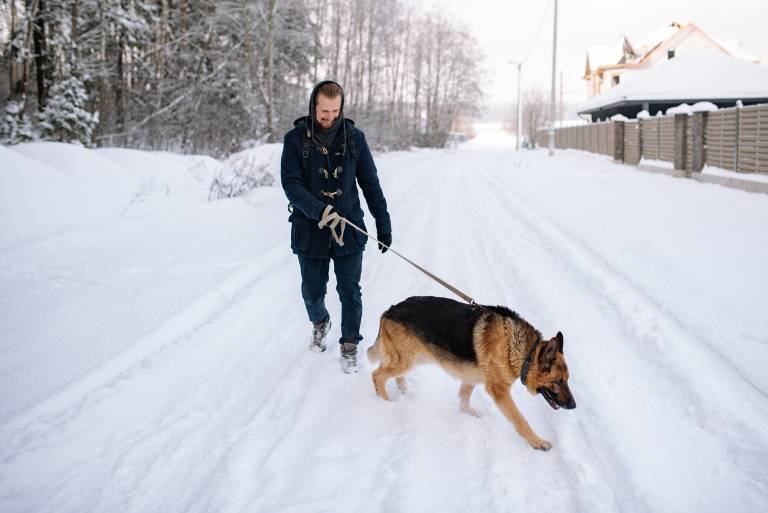How Much Is A Golden Retriever?
Post Date:
December 10, 2024
(Date Last Modified: November 13, 2025)
Golden Retrievers are a popular companion breed and many prospective owners first want to understand the likely upfront cost of acquiring one before committing to long-term care.
Average Purchase Price
Pet-quality Golden Retriever puppies from established, responsible breeders typically sell in a range of $800 to $2,000, depending on pedigree and included services such as initial vaccinations and microchipping[1].
Prospects sold as show-quality or with breeding rights frequently carry a higher tag, commonly ranging from $2,000 to $5,000 or more because of lineage, early training, and registration paperwork[1].
Adult Golden Retrievers rehomed through shelters or breed-specific rescues are often listed with adoption fees between $150 and $600, with many rescues including basic vet work and spay/neuter in that fee[2].
Comparatively, average breeder prices for pet-quality pups across listings frequently center around $1,200 to $3,000 when accounting for health testing, registration, and early care provided by the breeder[3].
Price outliers are common: advertised puppies under $500 can indicate minimal screening or commercial breeding conditions, while litters or individual pups priced above $5,000 generally reflect extensive health clearances, show potential, or included training and breeding rights[4].
| Category | Typical Price (USD) | Common Inclusions |
|---|---|---|
| Pet-quality breeder puppy | $800–$2,000 | Basic vaccines, microchip, registration |
| Show/breeding prospect | $2,000–$5,000+ | Pedigree papers, testing, early training |
| Rescue/adult rehome | $150–$600 | Shelter vetting, spay/neuter often included |
| Price outliers | Under $500 or over $5,000 | May indicate poor screening or premium services |
Factors That Affect Price
Pedigree and registration papers commonly change a puppy’s asking price because dogs with multi-generation show lines or titled parents often command higher fees; breeders who advertise American Kennel Club or equivalent registration typically add several hundred to a few thousand dollars to the base price[5].
Health clearances for hips, elbows, eyes, and cardiac screening are frequently listed separately or included as part of a premium; individual clearances such as an OFA hip evaluation or cardiac exam can add $200 to $600 in documented breeder costs per dog[8].
Age affects cost: puppies under 6 months generally sell for the highest prices, adolescents 6–18 months may be discounted by 10%–30%, and adults over 2 years rehomed by breeders or private owners can be priced lower or higher depending on training and temperament reports[1].
Coat color and markings influence market demand in some regions, with certain shades or rare markings sometimes increasing price quotes by a few hundred dollars, while sex-based pricing differences are often negligible but may appear when buyers prefer females for perceived ease of training or males for size[3].
Breeder reputation, demand cycles, and how frequently a breeder produces litters also factor into price: highly established breeders who average fewer litters per year commonly set prices 20%–50% above new or high-volume breeders because supply is limited and demand remains strong[4].
Breeder vs Rescue vs Pet Store Costs
Typical fees from reputable breeders often include initial vaccinations, microchipping, and a health guarantee; the bundled value of these services is commonly $200–$500 beyond the base sale price when itemized by cost centers[6].
Rescue and shelter adoption fees generally range from $75 to $600 and frequently cover core veterinary care such as a wellness exam, age-appropriate vaccines, and spay/neuter; rescues focused on a breed tend to charge on the higher end to fund medical screening programs[2].
Pet stores that source puppies from brokers or commercial breeders may advertise low upfront prices under $500 but those puppies often come without health screenings and carry increased risk of congenital or infectious disease, which can lead to higher early veterinary expenses[4].
Health and behavioral risks differ by source: breeder-sourced puppies from screened parents usually have lower short-term veterinary complication rates versus broker-sourced or some shelter-sourced dogs, while rescues can provide temperament assessments that reduce behavior-related rehoming costs[5].
Contracts and support vary: many reputable breeders offer a written contract with a health guarantee lasting 1–2 years and limited lifetime support, rescues commonly provide post-adoption counseling and a trial period, and pet stores typically provide minimal follow-up or contractual health warranties[1].
Pet-Quality vs Show/Breeding Price Differences
“Pet-quality” designation usually indicates a dog lacks one or more traits required for conformation shows or breeding—such pups are often priced at a fraction of show prospects, commonly 30%–70% of the going show price depending on the specific fault cited by the breeder[7].
Show-quality or breeding rights often include transfer of registration papers and sometimes explicit breeding contracts; buyers should expect separate fees for breeding rights or a surcharge that can exceed $1,000 above the pet-only price for the same litter[1].
Contracts for pet-quality puppies commonly contain a clause requiring spay/neuter by a specified age, and failure to comply may result in financial penalties or reclaimed registration—these clauses are standard and typically enforced to protect breeding lines[5].
Preparing a show prospect includes early socialization, conformation handling, and sometimes professional grooming; initial show-prep and basic competition training for the first year can cost $1,000–$4,000 depending on local trainer rates and show travel frequency[3].
Regional and Seasonal Price Variations
Urban areas with greater demand typically show asking prices 10%–40% higher than rural markets due to competition and higher operating costs for breeders and shelters[8].
Country- and region-specific trends exist: in countries with stricter import/export and quarantine regulations, transport plus quarantine can add $500–$2,000 to the cost when moving a dog across borders[10].
Seasonal demand often peaks in late spring and summer; breeders frequently list waiting lists with deposits and lead times of 1–6 months during high season, which can indirectly increase final prices due to supply constraints[3].
Transport fees for long-distance or professional courier services vary: ground transport within a region can cost $200–$700, while air-transport or specialized health-verified transfer services can exceed $1,000 when including health certificates and crates[10].
Initial One-Time Costs After Purchase
First veterinary visits typically include a wellness examination, core vaccinations, and parasite screening; initial vet bills for a new puppy often total $150–$400 depending on the clinic and services performed[9].
Spay or neuter procedures usually cost $200–$600 at general practices, while specialty clinics or geographic cost differences can push anesthesia and facility fees higher[6].
Essential supplies purchased up front—crate, bed, collar, leash, food and water bowls, and basic toys—commonly add $150–$500 depending on brand choices, with crates alone often costing $50–$200[3].
Initial training classes for puppies (group socialization and basic obedience) are frequently priced between $80 and $200 for a multi-week course in many metropolitan areas[3].
Recurring Annual Costs
Annual food costs for an average adult Golden Retriever are commonly $300–$900 per year depending on diet choice and region, with performance or prescription diets on the higher end[9].
Routine veterinary care including an annual exam, booster vaccines, and parasite prevention typically totals $200–$600 per year at conventional clinics; wellness plans that bundle these services can smooth costs but vary by provider[6].
Preventive medications for heartworm, flea, and tick control commonly cost $100–$300 annually depending on product choice and dog size[9].
Grooming and coat maintenance for Golden Retrievers, when using professional services, can run $300–$700 per year if scheduled every 6–12 weeks; owners who groom at home will have lower recurring spend but need to account for tools and supplies[3].
Health Risks and Potential Emergency Costs
Golden Retrievers have breed-associated risks such as hip and elbow dysplasia, certain cancers, and allergies; prevalence estimates and breed-specific screening protocols are documented by primary sources and breed organizations[5].
Diagnostic imaging for hip evaluations (radiographs) commonly costs $300–$600 per study, and corrective orthopedic surgeries such as total hip replacement can exceed $3,000–$7,000 per hip at specialty centers[6].
Cancer treatment costs vary widely: initial diagnostics and staging can total $1,000–$3,000, while chemotherapy protocols and surgery can push multi-month treatment totals into the $5,000–$20,000 range depending on the tumor type and treatment plan[5].
Because emergency hospital visits often result in immediate diagnostic testing and stabilization, owners should expect typical emergency visit costs of $500–$2,000 not including any advanced imaging or surgeries that follow initial stabilization[6].
Clinical maintenance such as appropriate fluid therapy is calculated using veterinary formulas (for example, maintenance fluids often approximate 40–60 mL/kg/day), and these clinical standards are referenced in veterinary manuals[5].
Lifetime Cost Estimates and Scenarios
Low-cost ownership scenarios that assume rescue adoption, minimal specialty care, and basic preventive services often estimate lifetime expenses of $8,000–$12,000 over a 10–12 year lifespan when accounting for food, routine care, and limited emergency events[9].
An average ownership scenario using breeder acquisition, routine veterinary care, quality nutrition, and occasional boarding or training typically totals $15,000–$30,000 across a 10–12 year life, depending heavily on regional cost variation and whether significant medical events occur[3].
High-cost scenarios that include show- or breeding-related expenses, frequent professional grooming, and one or more major medical events can push lifetime costs beyond $40,000 over a decade, especially if specialty surgeries or long-term cancer care are required[6].
Scenario assumptions that materially change totals include expected lifespan (8–14 years), frequency of major medical events (zero versus one or more), and lifestyle choices such as high-calorie performance diets or regular professional services, all of which should be explicitly listed when creating a personal budget[9].
Ways to Reduce Costs Responsibly
Adopting from a reputable rescue reduces upfront acquisition costs and can include core medical care, but prospective owners should verify the rescue’s screening and post-adoption support to avoid unexpected behavioral or health costs[2].
Selecting breeders who transparently provide health clearances and limited lifetime warranties can prevent large unexpected medical bills; negotiating included services such as a recent vet exam or an extended starter kit may lower immediate out-of-pocket spending[1].
Preventive strategies like timely vaccinations, monthly parasite control, weight management, and early training substantially reduce the chance of costly chronic conditions or behavior-related surrender; preventive care is typically less expensive annually than treating advanced disease or behavioral damage[7].
When considering pet insurance, owners should compare annual premiums against likely out-of-pocket expenses—insurance can be cost-effective for mitigating the financial risk of major illnesses, with typical policies covering emergencies and major conditions while wellness plans handle routine care[9].






